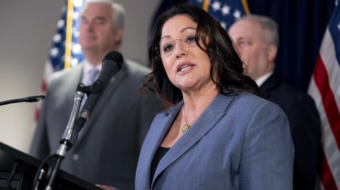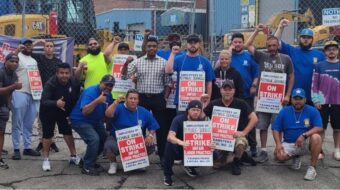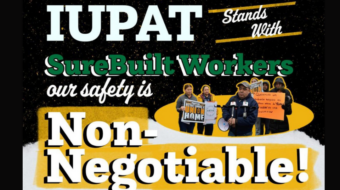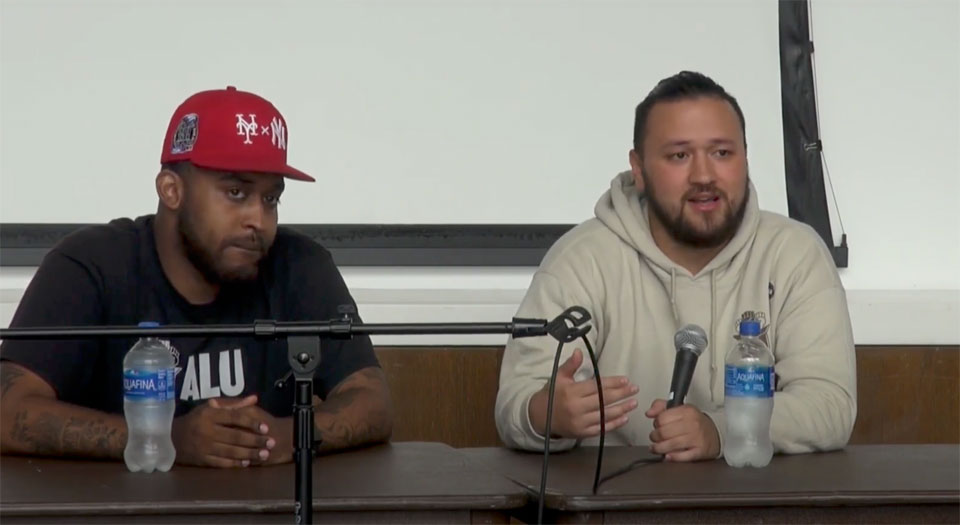
On Friday, May 6th, two organizers from the Amazon Labor Union, Tristan Martinez and Jordan Flowers were invited to speak at John Jay College. Hosted by Raphael Wakefield, the discussion centered around the continued struggle for Amazon to recognize the victory of the ALU at JFK8, along with the development and history of the union. Additionally, they spoke on the overall labor struggle at the present moment, concentrating on the union’s fight at Staten Island and how the ALU continues a legacy of militant labor organizing within the US.
Anti-union work continuing in JFK8
On April 1, JFK8 became the first Amazon warehouse in the country to win a union vote, establishing an important victory for the union. But even with this victory, there’s an ongoing struggle to rightfully recognize the ALU as a legitimate union and begin the process of negotiations. Both speakers detailed how the company delegitimizes the vote which occurred from March 25th-30th. Amazon originally demanded the JFK8 vote be thrown out, listing the National Labor Relations Board (NLRB) as favoring the union. Although all 25 of the listed objections from the company were deemed false, Amazon will continue to fight the fundamental right of its workers to unionize.
During the discussion, both Jordan and Martinez spoke on the extreme amounts of capital put into stopping the union from succeeding, specifically into warehouses JFK8 and sortation center LDJ5. In 2021, nearly $4.3 million was invested into anti-union tactics used in both warehouses. An important part of this campaign is Amazon hiring union busters who are paid between $1,500-$3000 a day, whose only purpose is to delegitimize the benefits of the union for workers.

Martinez emphasized that these anti-union crooks had a large influence in the recent LDJ5 vote cast from April 25-29. There were a number of conditions which made LDJ5 a particular challenge for organizing.
First, Amazon scheduled the voting of LDJ5 mere weeks after JFK8, making it difficult for the ALU to have conversations with workers and mobilize in time. The company also intensified its attacks within the warehouse, increasing the frequency of their anti-union classes. These classes continue to be held weekly and labeled as mandatory by the company, an activity that is illegal under federal labor law. The company also tacked up posters in English and Spanish to ‘Vote No!’ These strategies of repression are being increased by threatening to terminate any worker who shows support for the union. As Flowers detailed, for working-class people who rely on Amazon as a source of survival, the threat of unemployment forces workers to vote ‘no’ out of fear.
“Workers were scared that if they voted ‘yes’ then Amazon would just terminate them. JFK8 has about 8,000 workers, they have union busting classes every day. They had mandatory meetings without having a representative from ALU. A lot of these workers are watching us, they see Amazon doing this to us and they fear if they start organizing with us, Amazon will do the same thing with calling the cops on them and threatening their jobs.” Amazon has put millions into threatening and intimidating workers, but this will be fought with an equal degree of grassroots organizing and worker power.
At risk of termination
On May 9, two ALU organizers, Mat Cusick and Tristan Dutchin were fired for organizing with the ALU. Although this is illegal under labor law, Amazon stated that the two workers were terminated because they didn’t meet “production rates.” As the ALU continues to fight and win for workers interests, the company will increasingly use violent and reactionary strategies.
Amazon wants to maintain complete control of workers within the facility and this includes working conditions, wages, and the hiring and firing process. Without a union, a worker can be fired from Amazon without warning, without a chance to appeal the decision, and without a chance to have valid representation from a lawyer. While Amazon’s CEO makes billions from the economic exploitation of his employees, warehouse workers are at constant risk of losing their employment without explanation from management.
Flowers himself experienced these repressive policies and was fired. The company did not compensate him or consider how this termination would affect his livelihood. “I’ve been out for 3 years due to a medical issue, and Amazon has not paid me back once, no disability, nothing. That just shows how powerful this company is and they don’t care about their workers. Amazon is doing everything to get workers fired, but we have the ALU now.” The termination of workers is just one part of the $4.3 million anti-union campaign, but the union will continue to organize toward all workers’ political interests. This includes direct assistance in getting fired workers’ jobs back and protecting all workers at the Staten Island facility.
Labor Organizing in the 21st century
ALU’s April 1 victory has had a ripple effect within the labor movement, influencing over 100 warehouses to reach out to the ALU for assistance. But the history of this movement began two years earlier, coming out of the unsafe conditions during the pandemic and the contradictions inherent to the Capitalist system.
Both Tristen and Jordan spoke about the origin of the ALU and how the pandemic was a driving force toward organizing on behalf of workers at the Staten Island facility. In 2020, during the pandemic, Chris Smalls, Derrick Palmer, Jordan Flowers, Gerald Bryson, and Tristen Martinez formed the Congress of Essential Workers (T.C.O.E.W). They formed this group because Amazon repeatedly violated workers rights and created unsafe conditions. The company refused to give Personal Protective Equipment (PPE), did not provide up to 6 feet distance in the warehouse, and the buses that transported workers between the warehouse were overpacked and dangerous. The four organizers understood that they were risking their lives to go into a workplace that exploited them and their colleagues. The pandemic showed that even though the workers are the ones that risk their lives to make production possible, it is the company’s interests that are seen as primary. The company’s focus is on accumulating capital while the workers focus is on how to survive.
The development of ALU also came from the grassroots labor organizing of all the workers in the union. Both speakers highlighted that It was a combination of exploitative working conditions, (specifically health risks from the pandemic), an increase in trade labor consciousness, and speaking to workers directly about the union that helped maintain trust for the ALU.
The ALU knew that economic exploitation could only be stopped when workers themselves realized the full extent of their labor. The union created a new space where the demands of every worker are central because the role these workers play in production is essential. This took a group of grassroots and militant organizers who were able to convey that workers have agency over their workplace conditions. As Tristen Martinex pointed out, “Essential workers should be paid more, you should be valued. Because if you don’t do your job, what is the effect? What is the effect you would have on the economy and country if everyone who did your type of job stopped? Would this country be able to run without nurses or warehouse workers, so it made us realize what we do is really important. Nobody should be working 40 hours and unable to make rent, nobody should be giving time and years of their life to a company that doesn’t care about you or give you any benefits for your time.”
The fight goes on
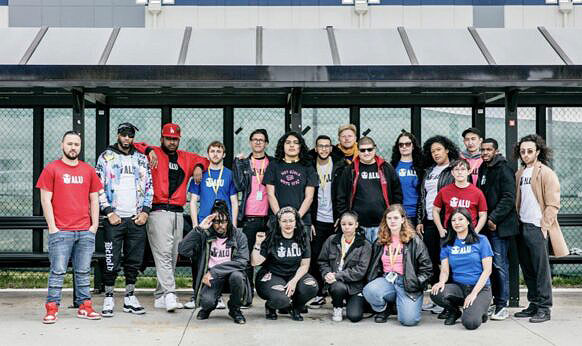
Although the LDJ5 building did not vote to unionize, this will not stop the union from continuing to work on behalf of the workers. Because ultimately it is the union that continues to fight for the interests of workers at both facilities. In fact, Flowers said there’s already been a victory for the union. Because JFK8 is a unionized warehouse, the company cannot initiate any change in policy before a contract is finalized. This includes the unpopular policy of removing all cell phones from the shop floor.
“Before you were allowed to have your phone out because of COVID. But slowly they started repealing that back, so phones weren’t going to be allowed in the facility anymore. But because we won at JFK8, it’s law that you can’t make any major policy changes to a unionized warehouse until you negotiate the contract. That would show workers that a union is already important, the union has already had a victory.
Because these victories show that the union will fight on behalf of all workers and provide real results. JFK8’s unionization came from a combination of rank and file organizing and the participation of thousands of workers, resulting in the defeat of the second largest company in the country. The ALU understands that it is workers that create wealth and it is the workers that will maintain power. At the end of the discussion, Tristen communicated this best, saying, “Us workers have more power than you think, when workers unite at the end of the day we outnumber the top 1%. We have more power than most people think and we want to make every worker know that that’s the case. You are not weak just because you’re not a worker and I feel like that’s what our victory had conveyed across the country.”



